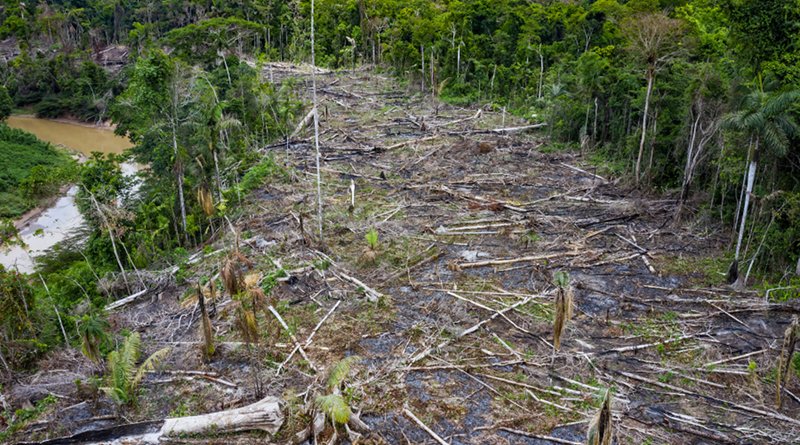In Brazilian Amazon, Savannization And Climate Change To Expose 12 Million To Lethal Heat Stress
Large-scale deforestation of the Amazon rainforest, combined with climate change, will increase the number of people in northern Brazil who are exposed to extreme heat–with potentially deadly results and devastating economic impacts, according to a groundbreaking study released today by Brazilian researchers in the journal Communications Earth & Environment.
Extreme heat levels, which are physiologically intolerable to the human body, will profoundly affect regions where highly vulnerable populations, including Indigenous Peoples, reside. This is the first study to quantify the combined impacts of rampant forest loss—which would eventually transform the Amazon into a savanna–and climate change on human health and productivity.
According to the study, Deforestation and climate change project increased risk of heat stress in the Brazilian Amazon, there is a deforestation threshold in the Amazon, beyond which human survival is threatened. Crossing this threshold causes an “extreme health effect,” which by 2100 could expose approximately 12 million people living in the northern states of Pará and Amazonas in Brazil to extreme risk of heat stress.
“Extreme heat conditions induced by deforestation may have significant and long-lasting adverse effects on human health. If deforestation continues at its current rate, the effects for our civilization will be dramatic,” said report co-author Paulo Nobre, senior researcher at Brazil’s National Institute for Space Research (INPE). “In addition to impacts on human health and survival, these findings have serious economic implications far beyond crop damage.” Paulo Nobre wrote the report with Beatriz Alves de Oliveira, Marcus Bottino, and Carlos Nobre.
High temperatures and humidity weaken the body’s cooling capabilities, resulting in increased body temperature. Sustained exposure to such conditions results in dehydration and exhaustion, and, in more severe cases, tension and collapse of vital functions, which can lead to death. In addition, heat stress affects mood and mental illness, and reduces physical and psychological performance.
Scientists already have a well-established understanding of how tropical deforestation contributes to global climate change through emitting carbon and reducing the ability of the world’s forests to take more carbon out of the atmosphere. A new body of research is emerging, showing how tropical deforestation has climate impacts beyond carbon: Deforestation immediately increases extreme heat locally and decreases regional and local rainfall.
In Brazil, this phenomenon is already apparent. Recent research has shown the combined effects of deforestation and climate change are being felt in the Amazon region, with the most extreme heat increases reported in large, deforested areas between 2003 and 2018. The agriculture industry is already feeling the impacts of this extreme heat and low rainfall.
The new study released today is the first to closely examine how increases in extreme heat will impact people. The study researchers found that the combination of deforestation and global warming could increase heat risks outdoor workers, who are already exposed to increased temperatures.
Added to that, the study found that human activities responsible for large-scale forest loss in the Amazon, which include forest fires and the expansion of agricultural and mining lead to unplanned urbanization, lack of basic sanitary infrastructure, and more frequent informal work—all of which further impact vulnerable people
When all these factors are combined, deforestation and its impacts lead to increased inequality and vulnerability, which interact with climate change to increase the urgent need for health and social protection services in the Brazilian Amazon region.
The study shows that effects play out regionally, and the most severe direct impacts likely will take place in northern Brazil. Of Brazil’s 5,565 municipalities, 16% of them (equivalent to 30 million inhabitants) might be impacted by thermal stress due to the savannization of the Amazon. Of the impacted population, 42% reside in municipalities in Brazil’s northern region, which includes areas with high social vulnerability.
In this region, approximately 12 million people could be exposed to extreme risk of heat stress by 2100. The authors claim that, with the savannization of the Amazon and limited adaptation capabilities in northern Brazil, residents could face precarious survival conditions, intensifying such effects as mass migration.
Additionally, increased exposure to thermal stress could reduce labor productivity in several areas of the economy, if workers are exposed to fatal heat conditions. In Brazil, outdoor workers are already exposed to heat stress, and projections indicate increasingly high-risk exposure over the next decades.
By 2030, a projected 1.5 °C increase in global average temperatures could reduce working hours in Brazil by the equivalent of 850,000 full-time jobs, especially in the agricultural and construction sectors. In agriculture, high risk associated with intense work and heat overload has already been observed among sugarcane cutters.
The researchers emphasize the urgent need for coordinated measures to avoid harmful effects on vulnerable populations. “The local effects of land use changes are directly linked to forest sustainability policies and strategies, but changes are within society’s reach. For example, the health sector could be an important source of policy solutions to mitigate risk and vulnerability,” argues Beatriz Oliveira, researcher at the Fundação Oswaldo Cruz (Fiocruz).
The researchers’ estimates did not consider population growth or changes in demographic structure or life expectancy. Thus, the results shown in the study reflect the isolated effects of climate change and savannization, and maybe interpreted to represent the effects observed if the current population were exposed to projected heat stress distributions.

